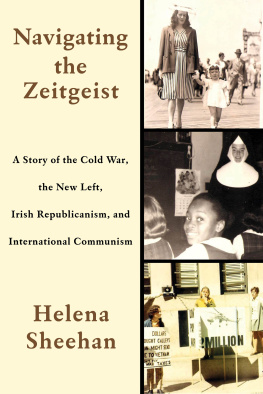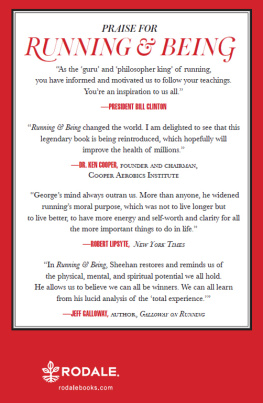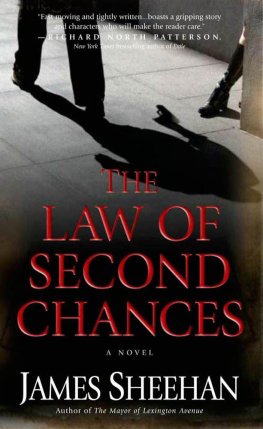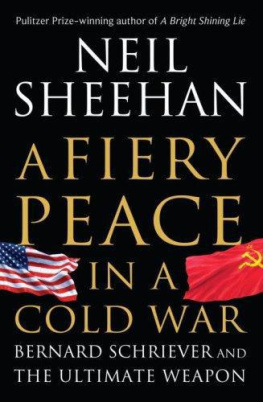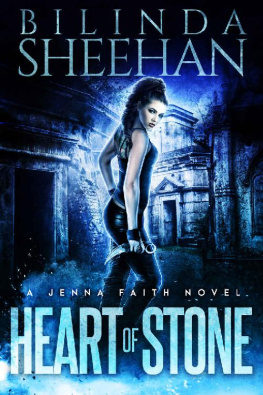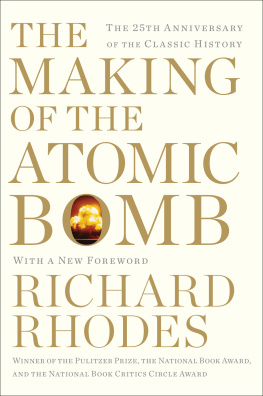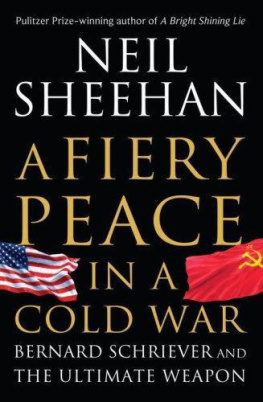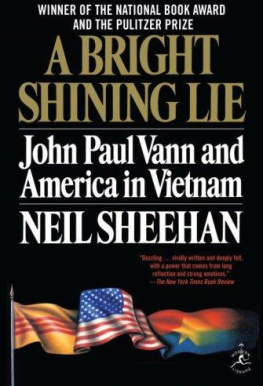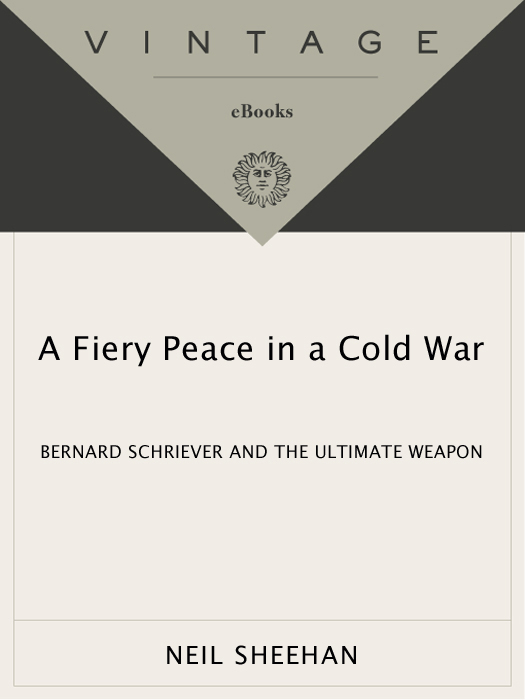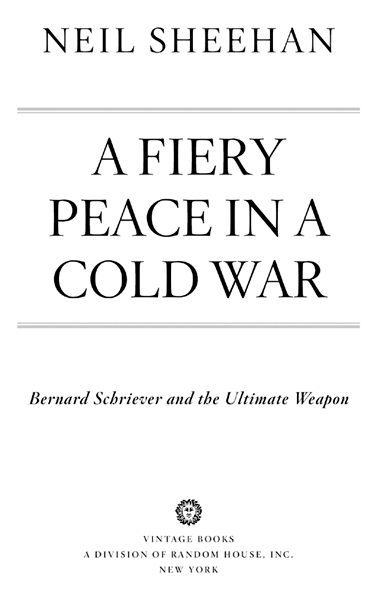Praise for Neil Sheehans
A FIERY PEACE IN A COLD WAR
A deep look at American defensive thinking in the Cold War. Sheehans book is rich in cultural detail, beyond iconic moments of the Cold War as refracted through the lens of the missile race.
Newsday
An ambitious story. Sheehan tells it well.
The Dallas Morning News
Absorbing. Sheehan is a terrific reporter and an excellent writer, capable of weaving multiple story lines into a seamless narrative. Unforgettable. More than a worthy successor to A Bright Shining Lie. It is hard to imagine a more accomplished and informative expos of the deep gears grinding in the engine room of the Cold War.
The Oregonian
A success story, in which the military, or a part of it anyway, instead of becoming mired in a folly of its own creation, prevailed over bureaucracy and incompetence and probably averted catastrophe.
The New York Times
Fascinating. Sheehans scope is vast, and the narrative proceeds with the measured beauty of a complex mathematical proof.
GQ
Neil Sheehan is a master of historical portraiture. His new book casts light on a critical but largely forgotten moment of the Cold War, with all the dazzling research and authority we have come to expect from him. Sheehan tells a fascinating story wonderfully vividly.
Sir Max Hastings
Schriever is a charismatic figure, and the supporting characters are fascinating, too.
The New Yorker
Schrievers part in the development of the ICBM is a story that needed to be told and Sheehan tells it with enthusiasm.
The Boston Globe
Here, masterfully recounted, is the epic tale of the decisive scientific battle of the Cold Warfor supremacy of the skies and spacetold through the remarkable story of Air Force general Bennie Schriever. Once again, the legendary reporter Neil Sheehan has unearthed a hidden trove of the history of our time. A stunning achievement.
Carl Bernstein
Sheehan does an excellent job of describing, in terms that a layman can follow, the technical challenges involved in developing an ICBM and how they were overcome.
Michael Dobbs, The Washington Post
A fascinating tale.
The Times-Picayune (New Orleans)
Neil Sheehan has triumphed again in this sweeping and absolutely fascinating book. Sheehan takes on the epic tale of how science, the military, and politics became interwoven during the Cold War. Its a crucially important topic, but also a colorful narrative tale filled with memorable characters such as Bennie Schriever and the geniuses he enlisted in his cause.
Walter Isaacson
A story of many characters, and some of the major ones, such as mathematician John von Neumann and Gen. Curtis LeMay, are very colorful. There is much to like in this book. Sheehans book helps make sense of things we know.
The Seattle Times
In this amazing book, Neil Sheehan shows us how the grand movements of history turn on the character of individuals. A Fiery Peace in a Cold War is the gripping account of the events, largely hidden until now, that saved the Cold War from turning into Armageddon.
Anthony Lewis
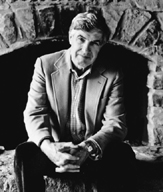
NEIL SHEEHAN
A FIERY PEACE IN A COLD WAR
Neil Sheehan is the author of A Bright Shining Lie, which won the National Book Award and the Pulitzer Prize for nonfiction in 1989. He spent three years in Vietnam as a war correspondent for United Press International and The New York Times and won numerous awards for his reporting. In 1971, he obtained the Pentagon Papers, which brought the Times the Pulitzer Prize Gold Medal for meritorious public service. Sheehan lives in Washington, D.C. He is married to the writer Susan Sheehan.
ALSO BY NEIL SHEEHAN
A Bright Shining Lie
The Arnheiter Affair
After the War Was Over
FIRST VINTAGE BOOKS EDITION, OCTOBER 2010
Copyright2009 by Neil Sheehan
All rights reserved. Published in the United States by Vintage Books, a division of Random House, Inc., New York, and in Canada by Random House of Canada Limited, Toronto. Originally published in hardcover in the United States by Random House, an imprint of The Random House Publishing Group, a division of Random House, Inc., New York, in 2009.
Vintage and colophon are registered trademarks of Random House, Inc.
The Library of Congress has cataloged the Random House edition as follows: Sheehan, Neil.
A fiery peace in a cold war: Bernard Schriever and the ultimate weapon / Neil Sheehan.
p. cm.
1. Schriever, Bernard A. 2. United States. Air ForceOfficersBiography.
3. GeneralsUnited StatesBiography. 4. Military engineersUnited StatesBiography.
5. Intercontinental ballistic missilesDesign and constructionHistory.
6. Intercontinental ballistic missilesUnited StatesHistory. 7. Nuclear weapons
United StatesHistory. 8. Cold War. 9. Aeronautics, MilitaryResearch
United StatesHistory. 10. AstronauticsResearchUnited StatesHistory.
I. Title.
E745.S34S44 2009
355.0092dc22
[B] 2009002247
eISBN: 978-0-307-74140-0
Author photograph Ron Blunt
www.vintagebooks.com
v3.1
For Susanwho else?
For Maria and Catherine
For Will
And for my grandson, Nicholas Sheehan Bruno
FOREWORD
W hen the Space Age is mentioned, most people think of Sputnik, the launching into orbit of the first man-made satellite by the Soviet Union on October 4, 1957, or the race between Russia and the United States to land men on the moon. Sputnik was a psychological thunderclap. It set off a paroxysm of fear that the Soviet Union had gained a commanding technological lead over the United States. The moon landing by Neil Armstrong and Edwin Aldrin on July 20, 1969, was its reverse: a spectacular feat of American technology with little in the way of practical benefits. This book is concerned with a quite different space race. This other race initiated Americas exploration and exploitation of space and was for the highest stakespreventing the Soviet Union from acquiring an overwhelming nuclear superiority that could tempt Soviet leaders into international blackmail and adventurism with calamitous results for human civilization. Its outcome thus directly affected the security of the United States and the non-Communist nations of Europe, as well as the preservation of the fragile equilibrium between the two superpowers during the Cold War. The story of this other race, of the man who led it, an Air Force officer named Bernard Schriever, of those who labored with him, of the times in which they grew up and came of age and the challenges and obstacles they had to overcome, forms the narrative of this book.
CONTENTS
PROLOGUE:
A Rite of Succession
G eneral Henry Harley Arnold, known as Hap because of his unusual smile, was in a hurry in January 1946. During the Second World War, which had ended the previous August with the surrender of Japan, he had created and led the greatest air armada ever assembled, the U.S. Army Air Forces. The stress of the war had exacted a toll on a fragile heart. He had suffered two heart attacks during the war and a third shortly after its conclusion. (He was to die of heart failure on January 15, 1950, at the age of just sixty-three.) He knew he would have to retire soon and turn command of his Army Air Forces over to his trusted friend and second man, Carl Tooey Spaatz.


